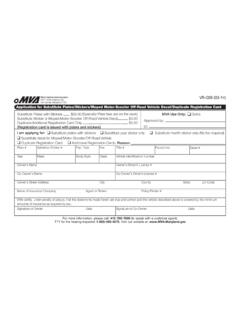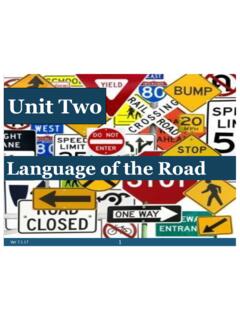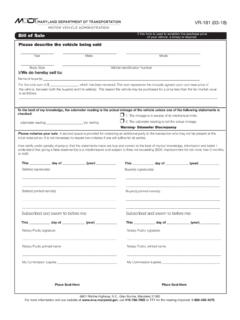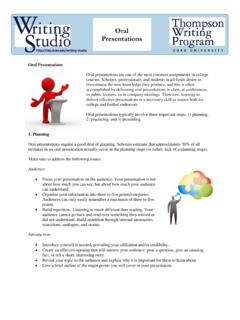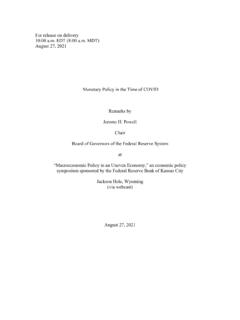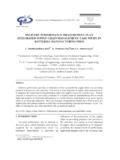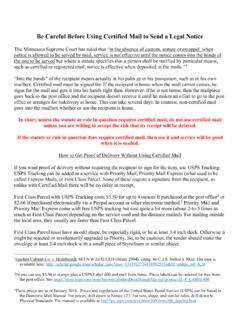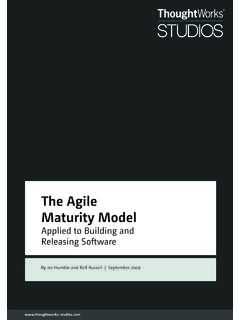Transcription of Unit Six: Driving Faster with More Risk
1 URBAN, SUBURBAN, AND RURAL Driving unit Six: Driving Faster with more Risk Ver For unit Six Students will be able to describe the skills necessary to safely and legally drive on urban, suburban, and rural roads. Space Management Steering Students will also be able to evaluate the inherent risks of these types of roads and determine how distraction will impact those risks . Students will be able to describe the types of vehicles typically found on urban, suburban, and rural roads and what laws apply to those vehicles including railroad safety. What hazards might a new driver see in an urban area? What hazards might a new driver see in a suburban area? What hazards might a new driver see in a rural area? What should a driver do at a railroad track? Ver Is The Impact Of Distraction? Ver Lights, Big City, & Risky Driving Work Zones Public Buses that may stop unexpectedly Commercial Vehicles What are the potential risks ? Ver Roads: Narrow, Congested Roads Parked cars People crossing the street between cars without looking carefully Limited ways to avoid crashes or change direction in an emergency Traffic Alleys Ver are the risks of this narrow, congested road?
2 Risk Factors On Urban Roads Mixed use roads: why are they risky? People coming and going to work People coming and going home People coming and going to shop Children coming and going to school People doing the unexpected all the time What if the driver in the white car was distracted or speeding? Ver : The risks According to a recent study, up to 50% of pedestrians who crossed against the light were distracted. A pedestrian is killed, on average, every two hours on American roads. Ver : The Law Pedestrians have the right-of-way at street crossings. They must obey traffic signals. A driver must yield to hearing, sight, or mobility impaired pedestrians in the crosswalk. Ver Search Is So Roads: A Variety Of Vehicles Buses Cars and Light Trucks Commercial Trucks delivery Trucks Bicycles Motorcycles Emergency Vehicles Ver and Service VehiclesFire Truck Tow Trucks and Service VehiclesAmbulancesLaw EnforcementVer and Service Vehicles: The Law Emergency vehicles always have the right of way when using lights or sirens.
3 When an emergency vehicle is approaching from behind, a driver must move as close as possible to the edge of the road and stop until it passes. If you are going in the same direction as the emergency vehicle, you may not pass it unless it stops or you are directed to do so by law enforcement. If an emergency vehicle, tow truck, or other service vehicle is pulled over to the side of the road, you must either move-over one lane or slow down to a safe speed. Ver Driving : Alleys Alleys create additional entry points onto roads. Vehicles may unexpectedly appear to merge onto a main road. Drivers should expect the unexpected. Ver My Horn Doesn t Help?What to do: Traffic is part of urban Driving . Stay calm. Pay attention. Stay NOT to do: Don t honk your horn. Don t get mad. Don t yell at other drivers. Ver Will A Driver Have To Do? Navigate One Way Streets. Navigate Through Complicated Right Turns On DrivingVer Way Streets One way streets are frequently found in urban areas.
4 Indicated by a black and white regulatory sign that shows the direction of traffic flow. May also have a red Do Not Entersign or Wrong Waysign Ver : Why Are They Risky? Intersections multiple conflict points Places where vehicles, pedestrians, and other road users may all be at the same time. Conflict points pose the greatest risks for crashes. High number of conflict points make it challenging for a driver to effectively search and evaluate all possible paths of travel. High number of conflict points make it likely that the road may change quickly and Driving : Intersections Intersections: Search Searching Constantly: Critical To Safe Driving In IntersectionsWho is next to you? Who is behind you? Who is at the crosswalk?Is there a bike lane?Are there parked cars around you? What are the road signs telling you? Ver : Evaluate Balance what you want to do & what you can you want to turnIs that really going to happen? Ver : Evaluate Successfully Ver : Execute Select the best lane of traffic.
5 Signal if necessary. Continuously search and evaluate the safety of your course of action. Yield to pedestrians and other vehicles if necessary. Allow for appropriate following and stopping distance. Be sure to stay in your lane. Maintain your lane position. Continue to search even as you go through the A Right Turn Search for any pedestrians & bicycles in your path. Signal your intent to turn at least 100 feet ahead of intersection. Check for any signs or traffic signals. Come to a complete stop. Follow process for : Making A Right TurnVer Right Turn on Red Need to search EXTREMELY carefully. Evaluate carefully all possible actions. Check for any signs. Need to stop and search again before making turn. Does a driver HAVE TO MAKEa right on red? Intersections: Making A Right Turn Ver A Left TurnSearch What are the possible risks for the red car to make a left turn? Evaluate What are the possible courses of action? IntersectionsVer : Making Left Turns Execute Yield to any oncoming traffic.
6 Search. Check for any signs restricting left turns. Signal at least 100 feet in advance. Adjust lane position. Reduce speed. Continue to search: Crosswalk Bike paths Path of travel Intended destination Begin turn when your front wheels are at the center of the intersection. Turn wheel counter-clockwise. Accelerate through turn until car is in line with your new path of travel. Stay in your lane. Complete turn by reversing steering process. Turn off signal if necessary. Ver two things can be done in a shared left turn lane? Turn left from a highway. Turn left onto a : Shared Left Turn Lanes What are the arrows telling a driver he/she can do? Ver : Shared Left Turn Lanes Search Check oncoming Is this a safe action to take? Signal, check mirrors, and left blind Move into shared lane. Proceed when clear. Do not drive in these lanes for long distances. Do not use them for passing other Roads: Parallel Parking Search What is beside you and behind you? Check for other road users.
7 Remember to check your mirrors. Remember a head check. Evaluate Do you have enough room? Ver Roads: Parallel Parking Execute Position your vehicle next to the car in front of your spot. Check mirrors continuously throughout process. Shift to reverse and search again. Turn steering wheel to the right. Look over right shoulder and back slowly. When your back left bumper is aligned with the middle of the car behind you, turn the wheel in proper direction. Continue to back up slowly, straightening steering wheel. When both the front and back of your vehicle aligns with the vehicles in front of and in back of you, you are in the Parking Ver Parking: Mistakes Failing to signal. Not getting close enough(or too close)to the vehicle in front of you. Hitting the curb as you are backing up. Hitting the car in front of or in back of yours. Failing to check mirrors. Failing to signal when entering or exiting spot. Ver Driving Ver Is A Suburban Road? Suburban roads Large roads, usually 3 or 4 lanes going in each direction.
8 Speed limits are usually between 30-55 mph. May connect smaller developments to larger more populated areas. Have many entrance and exit points for shops, malls, neighborhoods, and restaurants. Have larger and more complicated intersections. May also have significant traffic Roads: risks Many of the same risk groups as in urban areas. Variety of road users Traffic and congestion Roads are larger and higher speed than in urban areas. Intersections are more complicated. Many entry and exit points along road: Drivers going from neighborhoods or parking lots onto roads with speeds of On Suburban Roads: Yielding What is a yield? It does not necessarily mean to stop. It means to slow down and prepare to allow another driver to go in front of you. You may also have to stop to let another vehicle in front of you. There are laws for determining which vehicle must yield for another vehicle. This is also called right-of-way. Ver : Who Has Right-Of-Way? You should be prepared to yield: To a driver is at or arrives before you at the intersection, To a driver in the opposing traffic lane if you are making a left turn, To a driver on your right, if both of you arrive at the intersection at the same time, and To a driver on a public road if you are entering the highway from a driveway or a private you do not want to yield, you may end up sitting here.
9 Or Ver AND TASKS ON RURALR ural Roads: Trains, Tractors, And Deer Ver Roads: Risk Factors Trains Animals Curved roads with limited visibility Limited shoulder areas Higher speeds with no barriers Ver Most dangerous crossing without warning lights or gates. Trains can take 1-3 miles to stop. Look and listen for trains when approaching tracks. Never go under or around a railroad gate. Never stop on railroad tracks. Be especially alert after Roads: Deer Usually see them at dawn and dusk. Peak deer season is from October to January. Most frequently found on the outskirts of town and in heavily wooded areas. Deer almost never travel alone. If you see one deer, others are To Avoid A Crash with A Deer SLOW DOWN, especially at dawn or dusk. Look for the shine of eyes along the roadside. Use your high beams whenever the road is free of oncoming traffic. Deer can become mesmerized by steady, bright lights. If you see one on the road, slow down and flash your lights.
10 Pay close attention to warning signs indicating deer. If you are on a multi-lane road, drive in the center lane to give as much space to grazing deer as A Deer Never swerve to avoid a deer. Don t rely on gadgets to scare off deer. Call 911 if injured. Never touch an animal that is in the roadway. Report the incident to your insurance company. Ver Roads: Winding & Narrow Limited Visibility Limited shoulder space No divider between lanes Ver with Care Prepare to pass-Why do you want to? Search What is around you in all directions? Why is it especially critical to SEARCH? Evaluate Estimate the space & time needed to pass. Position yourself two to three seconds behind the vehicle you want to pass. Check mirrors and oncoming traffic. Check ahead for safe passing distance. Signal your : Execute Overtake the ongoing car Signal your intention and accelerate into passing lane. Accelerate quickly to an appropriate speed, but do not exceed the posted speed limit. Concentrate on the path ahead.



